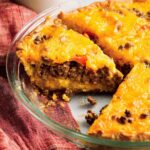The irresistible charm of Turkish Borek lies in its thin, golden layers of phyllo wrapped around a juicy, spiced ground beef filling. Each flaky bite bursts with flavor, combining savory meat, aromatic onion, and a light kick from Aleppo pepper — perfect for pairing with tea, ayran, or simply devouring on its own.
Traditionally coiled into an eye-catching spiral, this borek is both a feast for the eyes and the soul. Ideal for mezze platters, light lunches, or brunch spreads, this dish blends simple ingredients into a beautifully complex and comforting classic. Let your oven do the magic while your kitchen fills with the mouthwatering scent of homemade Turkish comfort.
Full Recipe:
-
3 tablespoons olive oil
-
1 large onion, diced
-
1 pound ground beef (80/20)
-
1 teaspoon Aleppo pepper (optional)
-
Kosher salt and freshly ground black pepper, to taste
-
1/2 cup water
-
1 cup milk
-
2 large eggs
-
1/2 cup neutral oil (such as canola or vegetable oil)
-
1 box frozen phyllo dough (15 to 18 sheets), thawed
-
Sesame seeds and nigella seeds or black sesame seeds, for topping
Directions:
-
Heat 2 tablespoons olive oil in a large skillet over medium heat. Add diced onions and sauté until soft and translucent, about 10 minutes.
-
Add ground beef and cook, breaking it up with a spatula, until completely browned, about 10 minutes.
-
Stir in Aleppo pepper (if using), 1 teaspoon salt, and 1/2 teaspoon black pepper.
-
Add 1/2 cup water and simmer until completely evaporated, about 15 minutes. Remove from heat and let the filling cool. Adjust seasoning if needed.
-
In a bowl, whisk together milk, eggs, and neutral oil to create the basting sauce.
-
Preheat oven to 375°F (190°C). Brush a 16-inch round baking pan with the remaining 1 tablespoon olive oil.
-
Place 2 sheets of phyllo on a clean surface, one over the other. Brush the top with the milk mixture.
-
Spoon 3–4 tablespoons of the meat filling along the long edge of the dough, then roll it up loosely.
-
Coil the log into a spiral and place in the center of the pan. Repeat with remaining phyllo and filling, continuing the spiral outward.
-
Brush the finished coil generously with the remaining milk mixture. Top with sesame seeds and nigella seeds.
-
Bake for 35 minutes, or until golden and crisp. Cut into wedges and serve warm.
Prep Time: 25 minutes | Cooking Time: 35 minutes | Total Time: 1 hour
Kcal: 375 kcal per serving | Servings: 8 servings
The Rich Heritage of Kıymalı Börek
Kıymalı Börek, or Turkish Borek with ground beef, is far more than just a pastry — it’s a piece of culinary history. Rooted in the centuries-old traditions of the Ottoman Empire, borek has traveled through generations, regions, and borders, making its mark across the Balkans, Middle East, Central Asia, and of course, Turkey. The name “börek” itself is derived from the Turkish word “bur,” meaning “to twist,” a fitting title for this beautifully coiled savory pastry.
Among the many fillings that can grace the delicate layers of dough, ground beef (kıyma) is one of the most cherished. While you’ll find countless versions made with spinach, cheese, or potatoes, the beef version remains a classic. Its rich, savory flavor and hearty texture make it especially satisfying, whether served for breakfast, as a midday snack, or a light dinner.
Cultural Significance in Turkish Cuisine
Börek holds a special place in the Turkish culinary identity. It’s one of those rare dishes that seamlessly blends into every meal of the day and transcends seasons. Traditionally enjoyed with a glass of hot black tea or a cool, tangy glass of ayran (a yogurt-based drink), börek is more than food—it’s a symbol of hospitality, warmth, and tradition.
In Turkish homes, making börek can be both a communal and celebratory act. Families gather to prepare large trays for weddings, holidays, or weekend brunches. It’s one of the most recognizable elements on a Turkish breakfast table (kahvaltı) and often appears at mezze spreads alongside olives, cheeses, and dips.
Moreover, Turkish borek isn’t limited to home kitchens. You’ll find it sold fresh at bakeries, cafes, and street vendors throughout Turkey. It’s one of the few dishes enjoyed equally by locals and tourists alike, offering comfort and familiarity with every bite.
The Art of Dough: From Yufka to Phyllo
Traditionally, börek is made with yufka, an unleavened, paper-thin dough that’s slightly thicker than phyllo (or filo) pastry. Yufka has been handmade by Turkish women for centuries, typically rolled out on large wooden surfaces and dried on clean linens before use. The result is a durable, slightly chewy texture that perfectly complements both soft and crispy fillings.
However, outside of Turkey, yufka can be hard to come by. That’s why modern recipes like this one opt for frozen phyllo sheets, which are more readily available and easier to work with. While phyllo tends to be flakier and more delicate, when properly basted with oil and milk (or yogurt), it can replicate the rich mouthfeel of yufka quite well.
Working with phyllo requires a bit of patience and care. The sheets are delicate and can dry out or tear easily. To avoid this, they’re often covered with a damp kitchen towel while assembling the börek. Each layer is brushed with a mixture of milk, eggs, and oil — a traditional Turkish method that gives the final pastry its golden color, crisp exterior, and rich flavor.
Flavor Profile: A Blend of Simple Ingredients and Deep Satisfaction
Kıymalı Börek celebrates simplicity in ingredients but depth in flavor. At its core, the filling consists of sautéed onions and ground beef seasoned with salt, pepper, and optionally, Aleppo pepper — a mildly spicy, fruity chili that adds warmth and complexity. The beef is slowly simmered until all the juices evaporate, creating a crumbly, deeply savory mixture that perfectly contrasts the lightness of the dough.
The richness of the meat is offset by the mild sweetness of the onions, which are cooked until soft and translucent. When wrapped in layers of phyllo and baked, the combination delivers a satisfying textural and taste experience — crispy on the outside, tender and juicy on the inside.
Optional toppings like sesame seeds and nigella seeds add not only a decorative finish but also bursts of nutty and peppery flavor. These small additions elevate the börek from a simple pastry to something aromatic and crave-worthy.
Spiral Presentation: More Than Just Visual Appeal
One of the most unique and visually striking aspects of this version of Kıymalı Börek is its spiral shape. Rather than layering sheets in a rectangular tray, this method rolls the filled sheets into long logs, then coils them into a tight spiral within a round baking dish. This coiling method isn’t just for aesthetics — it ensures that each slice reveals the perfect cross-section of crispy layers and juicy beef filling.
The spiral shape also makes this dish ideal for sharing. Whether you’re serving it at a family brunch or slicing it into wedges for a dinner party, this version of börek makes a beautiful centerpiece that looks as good as it tastes.
Versatility and Variations
Kıymalı Börek is endlessly adaptable. While beef is a favorite in many Turkish households, lamb can be substituted for an even richer, more traditional flavor. You can also mix in vegetables like chopped parsley, green onions, or even grated carrots to add freshness and texture.
For those seeking vegetarian options, the same coiled preparation can be applied to fillings made with feta cheese and herbs (peynirli börek), spinach (ıspanaklı börek), or mashed potatoes seasoned with cumin and paprika (patatesli börek). The dough and technique remain the same — only the filling changes, making börek a wonderfully flexible recipe.
Additionally, the milk mixture can be swapped with a yogurt-based wash, and some cooks add baking soda for a slightly puffier crust. Vegan variations are possible by using plant-based milk, oil, and meat substitutes.
Serving Suggestions and Pairings
One of the joys of börek is how well it fits into any meal. It can be served warm from the oven or even at room temperature. It pairs beautifully with yogurt-based sauces, pickled vegetables, or simple salads. For a more traditional Turkish feel, consider serving it with sliced cucumbers, tomatoes, olives, and a cup of Turkish tea.
If you’re entertaining guests or preparing a mezze spread, börek makes a great complement to dips like hummus, muhammara, or baba ghanoush. Because of its hearty texture, it can even stand in as a meat course in a vegetarian meal when paired with side dishes like bulgur pilaf or roasted vegetables.
Tips for Success
To ensure the best results when making Kıymalı Börek:
-
Always thaw phyllo dough in the fridge overnight. Do not rush the process in the microwave, or the dough may become gummy or tear.
-
Keep phyllo covered with a damp towel as you work to prevent drying out.
-
Don’t overstuff the phyllo rolls. Too much filling can tear the dough and prevent even cooking.
-
Let the meat filling cool completely before assembly to avoid making the dough soggy.
-
Generously brush each layer with the milk-egg-oil mixture — this is key for that beautiful golden-brown crust.
Conclusion: A Timeless Dish Worth Mastering
Kıymalı Börek is more than a recipe — it’s a culinary story passed down through generations. It’s humble yet grand, simple yet sophisticated. Whether you’re a seasoned home cook or exploring Turkish cuisine for the first time, this dish is a perfect place to start.
Not only does it offer comforting, hearty flavors, but it also invites you to experience a piece of Turkey’s rich food culture. The coiled shape adds flair, the filling delivers savory satisfaction, and the flaky layers keep you coming back for more.
Serve it to friends, enjoy it with family, or keep a tray in your fridge for an anytime treat. Once you’ve made your first spiral borek, you’ll understand why this dish has stood the test of time — and why it will become a favorite in your own kitchen too.





